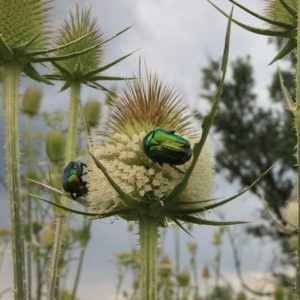 It shouldn’t be a surprise that the bug of the month for June would be the June bug, which can also be referred to as the June beetle or the green June beetle.
It shouldn’t be a surprise that the bug of the month for June would be the June bug, which can also be referred to as the June beetle or the green June beetle.
Where can the June bug be found?
The June bug is most abundant in the eastern portion of the United States. It can also be found in larger quantities in the southern areas of the United States, this is where Tennessee falls. The habitat of the June bug extends from Maine to Georgia, and as for west as Kansas. Which means it would be pretty hard to get away from this beetle.
What does the June bug look like?
The adult form is approximately 0.6 to 0.9 inches. It has wings that are dull and slightly metallic green. The body of the beetle has gold sides while the head, legs and the underside are a bright shiny green color.
What is the life cycle of a June bug?
Surprisingly the entire life cycle of a June bug lasts an entire year and it goes through 4 stage of growth. 
- The egg – Once the mating process has finished, the female will lay 60-75 eggs underground in a two week period. The eggs first appear white and elliptical in shape, later changing to a circular shape as the larvae develops.
- The Larva – During this stage the larvae is white in color with a brownish-black head and brown spiracles along the sides of the body. Once the larva is fully grown it is a peculiar glassy yellowish white.
- The Pupa – The pupation stage is where the larva undergoes a transformation, which can last up to 9 months.
- The Adult – This form will emerge in June after an 18 day period of the pupation stage. The June bug will most likely feed on fruits including berries, grapes, peaches, and nectarines. However, they are much more attracted to rotting fruit than ready-to-eat fruit.
How to control the June bug?
The larvae can cause the most damage to lawns, vegetables, and ornamental plants, especially those that have been mulched. This stage is more harmful to your yard than the adult beetle stage.
The milky spore disease can be used to control the June bug larva. The treatment begins working wherever larva are feeding. It does not pose a threat to other animals in the area. Once the treatment has taken root it can effectively control the larva for 10 or more years.
Let us know if we can help you with any June bug issues you might be having.
Contact us by calling (615) 220-1933 or visiting our contact page.
Learn more about June bugs.



